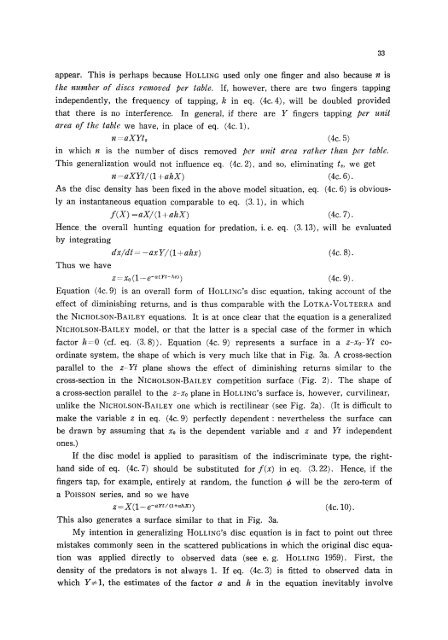A comparative study of models for predation and parasitism
A comparative study of models for predation and parasitism
A comparative study of models for predation and parasitism
You also want an ePaper? Increase the reach of your titles
YUMPU automatically turns print PDFs into web optimized ePapers that Google loves.
33<br />
appear. This is perhaps because HOLLING used only one finger <strong>and</strong> also because n is<br />
the number <strong>of</strong> discs removed per table. If, however, there are two fingers tapping<br />
independently, the frequency <strong>of</strong> tapping, k in eq. (4c. 4), will be doubled provided<br />
that there is no interference. In general, if there are Y fingers tapping per unit<br />
area <strong>of</strong> the table we have, in place <strong>of</strong> eq. (4c. 1),<br />
n =aXYG (4c. 5)<br />
in which n is the number <strong>of</strong> discs removed per unit area rather than per table.<br />
This generalization would not influence eq. (4c. 2), <strong>and</strong> so, eliminating t~, we get<br />
n = aXYt/(1 + ahX) (4c. 6).<br />
As the disc density has been fixed in the above model situation, eq. (4c. 6) is obviouslY<br />
an instantaneous equation comparable to eq. (3.1), in which<br />
f(X) =aX/ (l +ahX) (4c. 7).<br />
Hence the overall hunting equation <strong>for</strong> <strong>predation</strong>, i.e. eq. (3.13), will be evaluated<br />
by integrating<br />
dx/dt = -ax Y/ (1 + ahx) (4c. 8).<br />
Thus we have<br />
z =x0 (1 - e -~(rt-7~)) (4c. 9).<br />
Equation (4c. 9) is an overall <strong>for</strong>m <strong>of</strong> HOLLINC'S disc equation, taking account <strong>of</strong> the<br />
effect <strong>of</strong> diminishing returns, <strong>and</strong> is thus comparable with the LOTKA-VOLTERRA <strong>and</strong><br />
the NICHOLSON-BAILEY equations. It is at once clear that the equation is a generalized<br />
NICHOLSON-BAILEY model, or that the latter is a special case <strong>of</strong> the <strong>for</strong>mer in which<br />
factor h-0 (cf. eq. (3.8)). Equation (4c. 9) represents a surface in a Z-Xo-Yt coordinate<br />
system, the shape <strong>of</strong> which is very much like that in Fig. 3a. A cross-section<br />
parallel to the z-Yt plane shows the effect <strong>of</strong> diminishing returns similar to the<br />
cross-section in the NmHOLSON-BAILEY competition surface (Fig. 2). The shape <strong>of</strong><br />
a cross-section parallel to the Z-Xo plane in HOLLING'S surface is, however, curvilinear,<br />
unlike the NICHOLSON-BAILEY one which is rectilinear (see Fig. 2a). (It is difficult to<br />
make the variable z in eq. (4c. 9) perfectly dependent : nevertheless the surface can<br />
be drawn by assuming that Xo is the dependent variable <strong>and</strong> z <strong>and</strong> Yt independent<br />
ones.)<br />
If the disc model is applied to <strong>parasitism</strong> <strong>of</strong> the indiscriminate type, the righth<strong>and</strong><br />
side <strong>of</strong> eq. (4c. 7) should be substituted <strong>for</strong> f(x) in eq. (3. 22). Hence, if the<br />
fingers tap, <strong>for</strong> example, entirely at r<strong>and</strong>om, the function r will be the zero-term <strong>of</strong><br />
a POISSON series, <strong>and</strong> so we have<br />
z=X(1-e -a~/(l+ahz~) (4c. 10).<br />
This also generates a surface similar to that in Fig. 3a.<br />
My intention in generalizing HOLLING'S disc equation is in fact to point out three<br />
mistakes commonly seen in the scattered publications in which the original disc equation<br />
was applied directly to observed data (see e.g. HOLLING 1959). First, the<br />
density <strong>of</strong> the predators is not always 1. If eq. (4c. 3) is fitted to observed data in<br />
which Yr the estimates <strong>of</strong> the factor a <strong>and</strong> h in the equation inevitably involve















